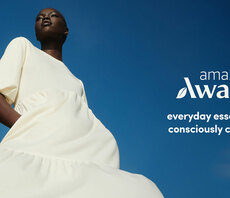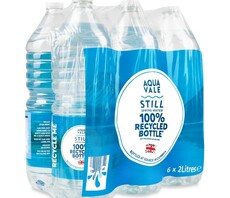Aware: Inside Amazon’s new private label for sustainable goods


Joel Makower gets the inside track on Amazon’s new sustainable product line
This week, Amazon is launching Aware, a new private-label brand of consumer products it has deemed sustainable, environmentally speaking. It’s a bold new initiative that could, if it succeeds, advance the overall market for greener products.
Available for customers in the United States, Canada and Europe, Aware has an initial focus in three categories of “everyday essentials”: apparel; household goods; and beauty products. Its catalogue to date is modest – slightly more than 50 products, from fleece sweatshirts to face cream, T-shirts to toilet paper – although both the offerings and product categories are expected to grow in the coming months.
“This is really about making progress over perfection and leveraging the best of Amazon,” Cyrus Wadia, Amazon’s head of sustainable product, told me recently. “It’s the best way for sustainability to get to scale in a way that hasn’t happened yet.”
The initiative began in 2020, not long after Wadia joined Amazon following a stint leading sustainable business and innovation at Nike and, prior to that, leading clean energy and materials research and development in the Obama White House. When he joined the online retailer, Wadia co-authored an internal document with a vision for a sustainability-focused brand. “But then our leadership said, ‘Let’s go bigger’,” said Wadia. “So it took on a life of its own.”
Aware was built on the foundation of Amazon’s Climate Pledge Friendly program, launched in 2020 and expanded last year, which highlights products that support the Climate Pledge, an initiative co-founded by Amazon that commits companies to achieve net-zero carbon by 2040. Products highlighted under the Climate Pledge Friendly program are certified by any of more than 30 third-party organisations.
The success of that initiative helped pave the way for Amazon to launch its own brand. All Amazon Aware products have been certified by at least one of these same organisations.
The Climate Pledge Friendly program began “moving us down this road on how we are going to decarbonize products and make them better for the customer and for the planet,” explained Wadia. “We were really proud of it, but we’re not going to be fully satisfied until there’s more selection in the marketplace for customers.”
Aware was the logical next step. One challenge was to overcome the confusion surrounding most so-called green products.
“When you’re a customer, it’s super confusing,” said Wadia. “What is the sustainable option that you want to go after? Is it backed by science or is it more of a marketing claim? I think brands are all over the map on this. What we’re trying to do at Amazon is to bring a lot of rigor to this. There’s a direct feedback loop between what customers demand in the market or ask for. And all of a sudden, you get momentum – you start to learn about what the customer demand is really shaping up to be.”
Part of the strategy, said Wadia, was to start with products customers need and regularly use – “essentials,” in Amazon’s argot. “These are timeless, everyday-use products. It’s not a luxury brand. And I think that’s very powerful. Because when I think about bringing the sustainability attribute and the quality attribute together with accessibility to customers, now we have something that I think is more reflective of where we need to go in order to scale more selection in the marketplace.”
Lightning speed
I asked Wadia about the difficulties Amazon encountered, both internally and externally, in launching Aware: designing products, getting manufacturers on board, mobilising the various teams at Amazon, and so on. Given the peculiarities of the sustainable product space – the lack of definitions, the vagaries of supply chains, the historically low levels of consumer engagement – it wouldn’t have surprised me that the company would need to surmount multiple hurdles.
But that doesn’t seem to be the case.
“It was easier than I thought,” said Wadia, speaking of the suppliers and contract manufacturers. “I was really impressed how fast they were able to turn and meet our criteria. We went from product idea concept to actual product in the marketplace at lightning speed I’d never seen, for example, at Nike. I never saw us move this fast on something that required new materials or ingredients or just working hand in hand with a supplier to make sure that we’re meeting all of the standards that we set.”
It’s clear that Amazon sees Aware as a learning lab, a platform for seeing what works, then quickly making adjustments.
When it comes to sustainability, “there’s no canonical definition I can pull off the shelf”, explained Wadia. “You’re kind of inventing towards this future state that we want. Amazon Aware is a pathway for us to keep testing and learning. It would be wrong to say we have all the answers, all the knowledge, all the tools, but this gets Amazon out of the gate faster in establishing all three of those.”
Talking the talk
Will consumers buy it? The marketplace is littered with the roadkill of brands that have traversed these roads. And consumers have proven frustratingly fickle when it comes to making greener purchases. While they have consistently talked the talk, professing their desire or intention to align their purchases with their values, their shopping carts – real or virtual – tend to look much as they always have.
And consumers will need to be convinced to choose Aware products over other comparable goods on the Amazon platform. Will, for example, they opt for the Aware-branded organic bath towels ($55 for four) versus the six-piece organic towel set offered by one of Amazon’s retailers ($45)? It will be interesting to see whether and how the Aware brand trumps competitors’ products, even when comparably priced.
It also remains to be seen how much Amazon can push the envelope – for example, offering refills for its Aware-branded beauty products. So far, only one product offers a refillable version, but it’s merely the original product minus the pump, requiring that you still need to buy two containers. Could Amazon’s ubiquitous delivery trucks some day pick up empties while it delivers refills (a la Loop)?
Yet another question is Aware’s carbon-neutral claim, which relies on “high-quality carbon credits”, which have proven to be a minefield for some companies. Amazon says that the footprint of each product is calculated by an external certifier using the GHG Protocol and covers emissions from materials, productions, distribution and end-of-life. It will be interesting to see how those standards hold up to the growing scrutiny of consumers, activists, regulators and other interested parties.
Wadia sees such questions as part and parcel of Amazon’s efforts to bring sustainable products to scale, part of a larger puzzle of which his company is just one piece.
“We have to drive big changes in supply-chain materials and chemicals, we have to drive big changes in our packaging and our design of that package, we have to make big changes in terms of circular business models,” he explained. “We’re early on data, we’re early on science, we’re early on clear definitions of what a sustainable product could look like. That’s not just Amazon’s job. That’s everybody’s job.”
This article first appeared at GreenBiz.com.














